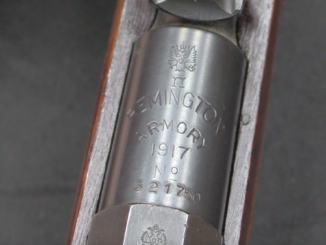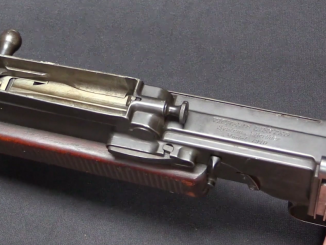The Murata was Japan’s first domestic manufactured military rifle. In its first iteration, it was an 11mm, single shot, black powder weapon and was adopted in 1880 (the Type 13). Before long, some problems in the design were discovered, and the Winchester company helped to resolve them. Winchester tooling was purchased by the Japanese government, and the improved Type 18 rifle was brought into service in 1885. A further and more significant modification would follow 4 years later as the Type 22. That iteration was reduced to an 8mm bore, and had a tubular magazine added – it would serve the Imperial Japanese military until the first Arisakas went into production.
Related Articles

Single Shot Rifles
1875 Lee Vertical Action Carbine at RIA

Bolt Action Rifles


Getting ready for Sunday School so will look at video later, but notice that the royal Chrysanthemum cartouche of the Emperor is defaced with an “X.” Does this denote a s7urrendered weapon as was the case in WWII? Just curious. Will be back to check for replies after Church. Have a nice one.
Ian answers your question on the video, but in short: no, it’s not a surrender marking. In this case it only means that the rifle was removed from IJA inventory, after which it was no longer considered personal property of tennō (the Emperor).
Okay, so this was retired from active service. But a big bore black powder rifle would still suffice for ceremonial or reenactment purposes, right? Or, more creatively, could this single-shot weapon be used by cops for training or for riot control with special rounds?
So I learned after returning form church and a Trustee meeting afterwards. The reason for the question was to determine if these weapons saw action and possible surrender since almost every Japanese weapon I have seen was so defaced if it was surrendered at the end of the war. It is a very accurate determination of the scenario of the transfer of the weapon from the Imperial forces to the Allies. Usually the only way one came into possession of an undamaged weapon was either from a deceased Japanese military member or one so severely wounded that they could not continue the fight. These were the ONLY honorable course of action in losing possession of a weapon with the imperial Seal intact.
the site links to a very interesting type 22!
Wrong rifle. We’re supposed to discuss the Murata rifle series here, and your link goes to a rifle that is obviously NOT a Murata family member!!!
Defaced Chrysanthemum: Not a sign of “surrender” or “Capture”, but simply a sign of “sold out of Imperial Service” for nearly all types of Japanese rifles from the 1870s to 1940s. 11mm and 8mm Muratas were sold to Emigrants going to South America ( Peru, Brazil) and also to China and South East Asia. Some were converted to 32 gauge and 28 gauge shotguns for Internal Japanese Use ( as well as for “Trade”); Rifles used by “schools” (ie, Colleges and Universities) were also “defaced/scrubbed”, and marked with the Character for “Gakko” (School). Even the so-called “mum defacement” by abrasive Grinding at the end of WW II was not very widespread, and was only practised by some US units on returning of Rifles to the US…it was not “general Policy” of either the Japanese nor the Allied Forces.
Take a view of the thousands of Chinese Captured Arisaka Rifles from WW II…very,very, few of these have been defaced.
Doc AV
The seemingly odd choice of the Beaumont-type V spring in the bolt handle to drive the striker was based on the local technology base. Even with the Winchester machinery, production of these rifles was at least partly “piecework” business, with metalsmiths in small shops making components lie screws, etc., including springs.
Japan’s metalsmiths at the time had very little prior experience with making and tempering coil springs. By comparison, leaf springs had been used in Japan for centuries, notably in the spring-catches which held the samurai armor caparison together. There was very little the local smiths didn’t know about the manufacture and proper tempering of leaf springs in any sort of metal, from bronze to steel.
As such, the Beaumont-type searage, with its big V-spring, made perfect sense from a manufacturing standpoint.
Incidentally, the 11 x 60R Murata round was based on the French 11 x 59R Gras round, rather than either of the Belgian 11mms (11 x 50R Albini M67/72 or 11 x 53R Comblain M71). This was because one of the Imperial Army’s first foreign rifle purchases was 11 x 59R Gras rifles, some of which came from France directly but others apparently transferred via Remington.
Remington also loaded the Gras 11mm ammunition, according to Barnes, so it’s not too much of a stretch to postulate that they helped develop the 11 x 60R round, which has a profile very like not just the Gras, but also that of the 11.15 x 58R (.43) Spanish Remington. It should be noted, however, that the Murata 11mm round has a heavier bullet than any of its “cousins”, resulting in greater ME when launched at similar velocities. (All of the above had MVs in the high 1400s to mid 1500s on average.)
The Murata round would probably not chamber in the slightly shorter Remington or Gras chambers, but the other two might chamber in the Murata. Which makes me wonder if any “surplus” Muratas ever showed up in the Philippine insurrection, as rifles firing the 11mm Remington and the 11.15 x 60R Mauser rounds were quite common in that fracas. The guerrillas tended to use the rounds interchangeably and even “roll their own” with a fine disregard for safe interoperability.
As for the likely fate of surplus Type 13s and 18s, ones converted to shotguns (probably 20-gauge or 24-gauge) might very well have been sold to Japanese colonists in South America, notably Peru. Murata also designed a single-shot, bolt-action shotgun for such use, that was still being manufactured and sold in .410 gauge until the beginning of World War Two.
cheers
eon
Shots in and around 11mm of the period seem to me like being at peak of black powder era. From your knowledge, were any of those retained for use with smoke-less propellant, as we call it today? Thanks.
The .45-70 would be an obvious example of a roughly 11mm/.45″ rifle cartridge still in widespread use, but I don’t think any of the bottlenecked European rifle cartridges survived long into the smokeless powder era. Many of them were loaded with smokeless powder during the transition era, but usually they were out of use before WW2, anyways.
See 11 x 59 Vickers. It was a smokeless-powder version of the 11 x 59R Gras intended for use in the Hotchkiss 11mm “balloon Gun” of WW1, and was also used in Vickers-Maxim HMGs also chambered for 11 x 59R.
It was developed because the British Army wanted a heavy MG round with more power and velocity (and less drop) for AA shooting, and also because neither the Hotchkiss (von Odkolek/Benet/Mercie’) or the Maxim actions “liked” the Gras cartridge, with case-head separations, “crumples”, failures to feed, and debulletings all being common aggravations. Which is hardly surprising in a round which after all, was designed for a single-shot rifle, and was later adapted to a tube-magazine bolt-action manual repeater. Much less stress on the cartridge in either one than you get in a 600-round-per-minute automatic weapon. The 11 x 59 Vickers had a stronger case head, a stronger case wall, and of course was designed for smokeless powder pressures rather than black powder.
The 11 x 59 Vickers was loaded with regular British Powder, Rifle, Cordite (Modified), double-base smokeless powder, a 450-grain solid bullet or a 500-grain incendiary tracer (by far more common), and sent said slugs out the muzzle at about 1600 F/S. This works out to about 2,850 FPE ME for the tracer, which is about the ME of a standard .30-06.
Of course, it must be remembered that town-gas filled kite balloons and hydrogen-filled Zeppelins weren’t armored, and tended to blow up spectacularly if anything punched through their thin skinning and into a gasbag. So for the job it did, the 11 x 59 Vickers had all the power it needed, and probably then some.
cheers
eon
Re: zeppelins, it’s something of a myth that they would ignite when punctured. They were actually very hard to shoot down before proper incendiary rounds were produced. Even the early incendiary rounds were surprisingly ineffective. 2nd-Lt Leefe-Robinson fired three (Lewis) drums of Brock and Pomeroy ammunition into SL-11 before it finally ignited. Assuming he was using the aircraft drums, that’s nearly 300 rounds of incendiary and explosive ammunition before the airship burnt. (Interestingly enough, the crew of SL-11 showed no indication that they even knew that Leefe-Robinson was attacking them.)
As was mentioned, the longest-lasting 1mm round was the aircraft Vickers cartridge, where the larger bullet allowed the use of a big incendiary payload which was useful for shooting at aircraft. Otherwise everyone wanted more velocity in order to get a longer/flatter trajectory and that meant going to small and light projectiles (6.5-8mm).
http://members.shaw.ca/tju/muratashotgunpix.htm
Thank you very much!
🙂
cheers
eon
11×59 for use in vickers guns had a flat noze copper or brass cored bullet and the cardboard package wore the mention in french dangerous if used in a mod 70-74 , 74 and 74-84 rifle
just imagine firing one of these cordite filled rounds in a gras
Latest recorded manufacture of 11mm59 in a french arsenal loaded with smokeless powder typebn3f with undersized round nose copper coated bullet for use in rifles
was manufactured in le mans in autumn 1936
don t we stick to obsolete stuff
No-one seems to recognize that the band with the bayonet lug was attached in a wrong way, so that the flat side of the lug faces forwards and the round face backwards – and the lug on the left side of the barrel. Photographs of other Muratas indicate the lug on the right side.
I recently came into what I believe is a Type-13 Murada. Unfortunately, the exterior is pitted and I can not read any of the markings or serial number. The action looks the same, bolt, etc. but the stock doesn’t look anything like the military version. It has a nicely checkered pattern and even an inlay at the front of the fore-end (stock is all one piece). Extractor is missing as the video states. Wondering if this was some sort of civilian make as it has no “Mum” on it at all. Any assistance in identifying it would be appreciated. I can send pictures.